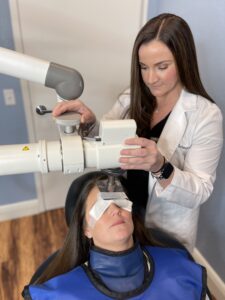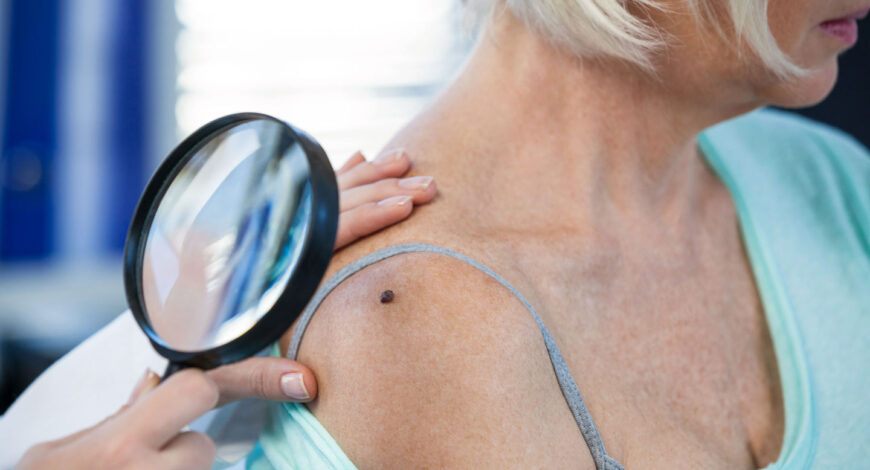Medical dermatology addresses concerns regarding the hair, skin and nails as well as the treatments to address those concerns. Some common conditions you might seek treatment for at MidState are:
- Acne
- Alopecia areata
- Dry skin
- Eczema
- Hidradenitis suppurativa
- Hyperhidrosis
- Melanoma (skin cancer)
- Nail fungus
- Psoriasis
- Rashes
- Rosacea
- Scars
- Shingles
- Skin cancer
- Vitiligo
- Warts
Superficial Radiation Treatment- SRT
 Superficial Radiation Treatment is a non-surgical alternative used to treat basal cell carcinoma and squamous cell carcinoma. The goal of SRT is to destroy the skin cancer by administering superficial radiation to a defined treatment area with as little damage to the surrounding tissue as possible. It is a highly effective treatment and typically patients are left with a cosmetically appeasing scar and do not require any physical restrictions during treatment. SRT has a cure rate of 95-98%. Appointments are usually two to three times a week with the average number of treatments being 12-16. Treatment appointments are quick and easy, with a dedicated staff member to assist you.
Superficial Radiation Treatment is a non-surgical alternative used to treat basal cell carcinoma and squamous cell carcinoma. The goal of SRT is to destroy the skin cancer by administering superficial radiation to a defined treatment area with as little damage to the surrounding tissue as possible. It is a highly effective treatment and typically patients are left with a cosmetically appeasing scar and do not require any physical restrictions during treatment. SRT has a cure rate of 95-98%. Appointments are usually two to three times a week with the average number of treatments being 12-16. Treatment appointments are quick and easy, with a dedicated staff member to assist you.
XTRAC- Psoriasis & Vitiligo
XTRAC is the only FDA-cleared, clinically proven excimer laser that gets skin clear of psoriasis—and it works fast, with many patients seeing significant improvement and long-lasting remissions. Because XTRAC delivers a highly targeted, therapeutic beam of UVB light only to areas of the skin affected by psoriasis, healthy skin surrounding the lesions stays that way.
XTRAC clears the symptoms, prolongs the remission and returns skin to a clinically healthy state in record time. All of which means XTRAC delivers consistently predictable results so patients experience more good days of living than bad.
Quick Facts
- Effective treatment—symptoms reduced generally in 10-12 treatment sessions
- Long-lasting relief—typically several months free of symptoms”
- Simple, painless treatment—sessions are very short
- Relief without messy creams and daily skin care regimen
- Covered by most major insurance companies, available by Rx
XTRAC treatments can minimize and, in many cases, even eliminate Vitligo depigmented patches. The XTRAC [308 nm] excimer laser delivers a targeted beam of UVB light and only the areas of skin affected by Vitiligo receive the laser energy.
Though the laser spot size measures only 18mm x 18mm, due to rapid exposure times, relatively large, discrete areas can be treated in just five to 10 minutes, which is much quicker than the duration of conventional phototherapy light sessions. And most importantly, XTRAC treatments achieve complete response rates faster in a higher proportion of patients.
Photodynamic Therapy (Bluelight)
Photodynamic therapy is approved by the FDA for treatment of actinic keratoses. AK’s are precancerous skin growths caused by sun damage in the cells outermost layer. The procedure involves three steps. Your provider will apply an aminolevulinic acid, a liquid photosensitizing agent, directly to the affected area of skin. Then, patients will sit with the ALA on the treatment area for an incubation period. Once the incubation period has ended, patients will enter a U-shaped blue florescent lamp which curves around for treatment. During treatment, patients may feel a tingling or mild burning sensation but upon completion of treatment any discomfort will stop. After treatment, skin may appear red and flaky for up to 2 weeks. The area will be more sensitive to light, so it’s important to protect the skin for 48 hrs after treatment. Most patients tolerate the treatment very well, with only moderate downtime.

